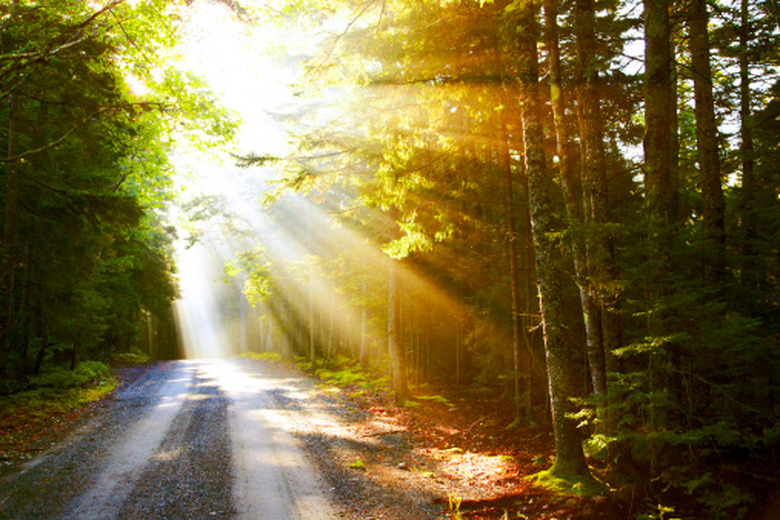What Happens During Photosynthesis In Plants?
The importance of photosynthesis cannot be overstated. Plants use sunlight to make food, and then you eat those plants. When you eat a juicy steak, you are only one step removed from the process of photosynthesis. Thanks to photosynthesis, you are powered by the energy of sunlight. You probably already know that photosynthesis takes light, water and carbon dioxide and uses those things to make oxygen and food, but there is more to the story of what happens during photosynthesis in plants.
The Light Reactions
The Light Reactions
Photosynthesis in plants happens in two distinct phases. The first of the two is called the light reactions, and the second is called the Calvin cycle (or the dark reactions). The light reactions are all about one thing: harvesting energy from light.
For the light reactions to happen, we need two things: water and sunlight. If you have any houseplants, you've probably noticed that they don't do well without these things. Photosynthesis can't even begin without light and water.
Oxygen Is a Byproduct of Photosynthesis
Oxygen Is a Byproduct of Photosynthesis
The process of photosynthesis begins when a single particle of light, called a photon, hits a molecule of chlorophyll that is embedded within a protein called a photosystem (specifically Photosystem II). That photon is traveling at the speed of light, so it has a lot of energy.
When it hits the chlorophyll molecule, it hits it hard enough to knock off a single charged particle called an electron. That excited electron hurries away from the photosystem, while the chlorophyll molecule rips apart a single water molecule in order to replace its lost electron. This creates oxygen, a byproduct of photosynthesis.
Electron Excitement!
Electron Excitement!
Back to the electron. That energized electron hops over to another chlorophyll-holding photosystem (Photosystem I), where it replaces an electron that was also excited by a single photon of light. The electron it replaced, however, zips away to complete an electron-carrying molecule called – get ready for it – nicotinamide adenine dinucleotide phosphate, which is more commonly known as NADPH. This process also generates a small amount of the energy-holding molecule called adenosine triphosphate (better known as ATP).
This is a lot to take in, but to sum up: The light reactions take in energy from light and use water to convert that energy into two intermediate forms, ATP and NADPH. If you're curious about what happens to those, you'll have to read on.
The Calvin Cycle
The Calvin Cycle
The second part of photosynthesis is called the Calvin cycle (or the light independent reactions). The light reactions go to the trouble of harnessing sunlight so the Calvin cycle can do its job, which is to make sugars. You can think of the Calvin cycle as a machine that makes sugars. The machine is powered by NADPH and ATP, both molecules made by the light reactions that act like batteries to keep the Calvin Cycle churning away. Carbon dioxide is fed into the machine as a raw material to make the sugars from.
How Are Sugars Made During Photosynthesis?
How Are Sugars Made During Photosynthesis?
The production of sugar during photosynthesis is a bit of a complicated process which happens in three general phases. The first phase is fixation. This happens when carbon dioxide is grabbed by an enzyme called RuBisCo, which converts the carbon dioxide from an inorganic molecule into a friendlier and easier to work with organic form.
In the reduction phase, some ATP and NADPH are consumed. This transfers their energy to the organic compounds by adding electrons. This generates three-carbon sugars that are then converted to six-carbon sugars, which are the main byproduct of the Calvin cycle. Phase three, the regeneration phase, simply resets RuBisCo so the process can begin again.
For every six molecules of carbon dioxide that go in, the Calvin cycle breaks apart and reassembles the carbon and oxygen atoms from those molecules into a molecule called glucose, which you know of as sugar.
Why Make Sugar?
Why Make Sugar?
Sugar is the most important byproduct of photosynthesis. Sugar holds quite a bit of energy, which makes it a fantastic food for the plant. But that's not all the sugar is used for. Most plant structures are made up of sugars in some form, whether it is in long, rigid chains known as cellulose, or thick coiled strings we call starch.
Sugar is also a great food source for animals, which is why there should always be plenty of vegetables on your plate. All of the energy you get from your food was converted from sunlight by this process. It's amazing to think that your body runs on solar power!
Cite This Article
MLA
Brennan, John. "What Happens During Photosynthesis In Plants?" sciencing.com, https://www.sciencing.com/what-happens-during-photosynthesis-in-plants-12437676/. 30 September 2021.
APA
Brennan, John. (2021, September 30). What Happens During Photosynthesis In Plants?. sciencing.com. Retrieved from https://www.sciencing.com/what-happens-during-photosynthesis-in-plants-12437676/
Chicago
Brennan, John. What Happens During Photosynthesis In Plants? last modified March 24, 2022. https://www.sciencing.com/what-happens-during-photosynthesis-in-plants-12437676/
